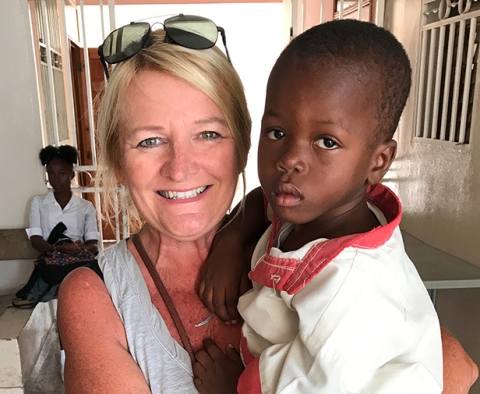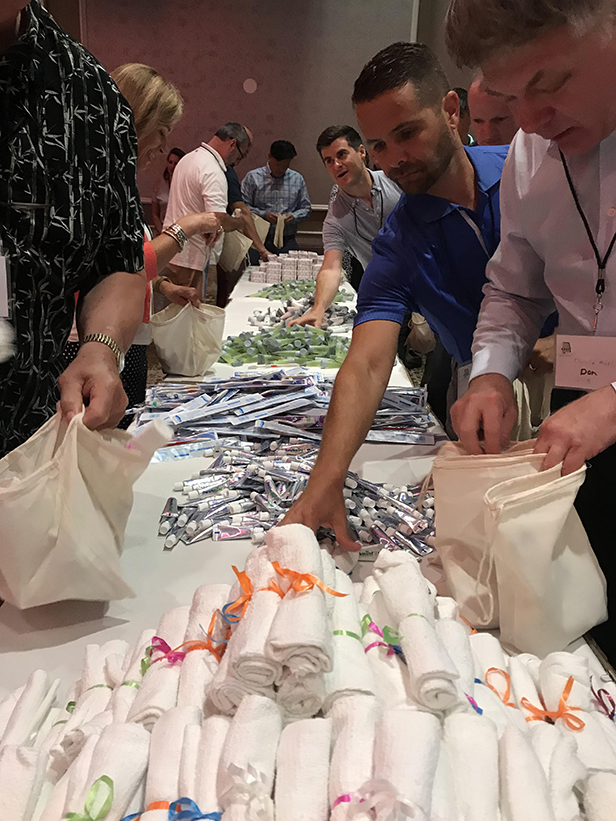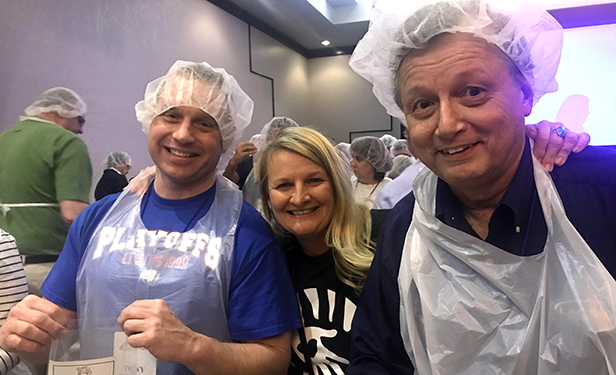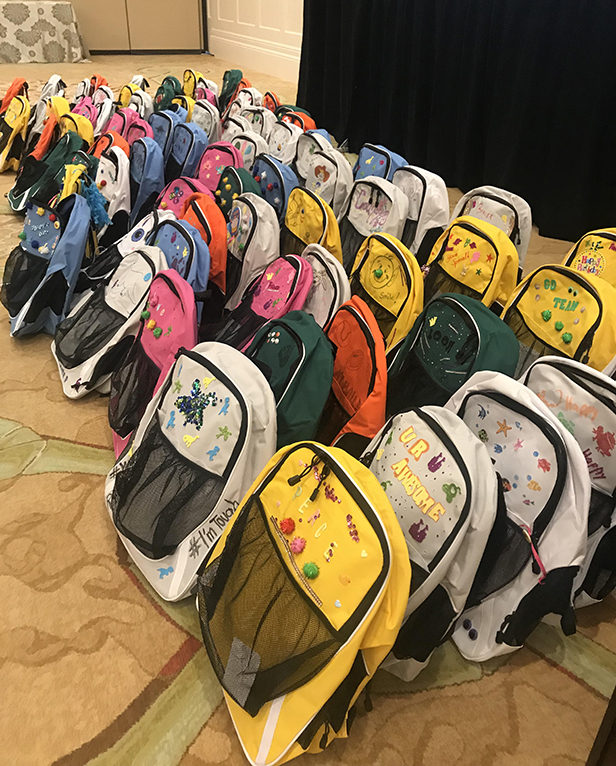GivingBack Interview: Tammi Runzler, Executive Vice President, CSRconnections

Speak with Tammi Runzler for just a few minutes and it’s obvious she’s one of those special individuals with a deep passion for making a difference. A 30-year veteran of the meetings, events and destination marketing industries, Runzler recently co-founded CSRconnections, a corporate social responsibility program planning company that connects organizations with customized CSR opportunities designed to engage attendees while positively impacting the destinations that host their events.
As an enthusiastic proponent of CSR at events, I was excited to sit down with Runzler to hear about her journey from Senior Vice President of Sales at Visit Orlando to her new role helping organizations make the world a better place, one event at a time.
TSNN: When did you become interested in CSR and how did this passion fuel your career path?
Tammi Runzler: More than a decade ago, when I was still in my leadership role at Visit Orlando, I started becoming more aware of organizations coming into destinations for meetings and events that were incorporating CSR activities and planning into their programs. I started to see the amazing benefits for those that were the early embracers of CSR, benefits that were so far-reaching – for the organizations choosing to behave in a socially responsible manner, the sponsors of these activities, for the participants that got to roll up their sleeves and participate in a cool activity and then, of course, for those organizations that are the recipients of the donations that typically occur.
So from a business perspective, I fell in love with the benefits of CSR because they were so obvious to me. That started my passion for wanting my team and me to be the champions of corporate social responsibility, and I started educating myself so I could be a resource for our customers and clients. It became a personal and professional passion for me and subsequently led me on the path of continuing to focus on CSR, becoming more proficient at it, and a couple of years ago, deciding to start a business with my colleague, Tim Lamont, to help others become passionate about it, too, and learn how to execute CSR activities that are truly impactful.
TSNN: Why did you see the need for a company dedicated to CSR for the events industry?
TR: While I started a company, what I feel like I’m really doing is offering a solution to the industry I love about something I’m very passionate about. For the last decade, I’ve heard so many event planners say, “CSR sounds great and we want to do it but it’s confusing and challenging for my staff,” and I kept assuming that eventually I wouldn’t hear that anymore but unfortunately, that isn’t true. So instead of just standing there and smiling and nodding while people were saying those things, I decided to offer a solution to make CSR simple and pain-free. With my business model, I can help any type or size of organization with any budget and schedule restrictions and incorporate some kind of social responsibility into their programming. Once we’re able to do that, (organizations) fall in love with it, it becomes part of their culture and they keep seeing all the benefits.

TSNN: What does your role at CSRConnections entail?
TR: I’m 100 percent hands-on. Usually what happens is planners hear about CSRConnections and reach out, either because they’ve known me before or they just need a CSR activity. I’ll start with a simple conversation trying to understand some of the logistics and a little of the demographics of the attendees as well as the organizational culture. Then I go back and start coming up with some creative designs of what might work for them – it’s not a one-size-fits-all – and then present them with some options.
Usually, when I come back with those, people are enthusiastic and able to start envisioning what their program would look like with CSR incorporated. After we find what works for them, I typically stay involved almost as an extension of their team in setting it up, doing everything we need to do on the logistical side, working directly with the facility and also helping to identify who’s going to be receiving the donation. Then I go onsite as the CSR coordinator and help execute, so it’s an a to z process – I start from the very beginning all the way through the execution and it works very nicely.
TSNN: What are some types of activities and donation programs that CSRConnections offers?
TR: I have a portfolio of all types of activities that could be everything from the very straightforward backpack stuffing activity, to long, coordinated teambuilding activities that have an educational component. So it can be a simple or more complex depending on what the customer is trying to accomplish.
Some of the more straightforward activities that I’ve done a lot of over the past couple of years have been backpack stuffing, high-energy meal packing and hygiene kit stuffing. The beauty of those is you can do them for pretty much any sized group and get really creative with space. Unfortunately, the need for those types of products is everywhere, so I can easily find multiple organizations anywhere that need food, hygiene kits, school products, and those are very impactful and easy events for any organization to incorporate.
The more complex, teambuilding kinds of events that we’ve done range from customizing wheelchairs to accommodate people with special challenges, to working with the Phoenix fire department on a customized event that provided them with all the supplies they needed to continue their bicycling safety program for the area school system. The fire chief and a lot of his staff participated in the four-hour activity and they were immensely grateful that instead of just calling and telling them that we were going to do a donation for them, we reached out and made a point of understanding their specific needs. Their program didn’t have any resources and was only able to continue because that corporation went in and decided they wanted to do something and as a result, made a huge impact on that community.
TSNN: Have you carried out any CSR events that have been particularly impactful for you personally?
TR: A few months ago, I had a company come to me that was doing events all over the country and wanted to help victims of human trafficking. They said they had a moderate budget, their events weren’t huge but in addition to helping human trafficking victims, they wanted to improve their networking opportunities. So I worked with ECPAT-USA to educate myself and understand what victims of human trafficking might need while they’re in the rescue process and then developed what I call “Rescue Kits.” I was able to go into nine cities in Sept. with this organization and develop an activity that not only enhanced the event’s networking efforts but also resulted in these amazing rescue bags containing 16 items that ECPAT had put on their wish list. When they get victims of human trafficking out of a dangerous situation and en route to a safe house, these kits are now being handed to those victims.
I can’t tell you how emotional this has been for everybody who’s been involved in providing these relief kits because in the process we have learned information that you never want to learn. In Atlanta, for instance, the average age of the person being rescued is 12, and for most of these young people, when they’re pulled out of a dangerous situation by law enforcement, they’re put in the back of a police car and they have nothing. So one thing that was important to us was to give them a nice canvas bag to make them feel secure right away with items they’d need for comfort, like a pair of comfy socks to put on and a notepad and a pen so they could write things down.

TSNN: So should establishing an emotional connection to a CSR activity be an important consideration for planners?
TR: Yes, if you can emotionally connect the participants to the cause, it’s like fireworks go off inside of your head and your heart – you’re actually touching things that are immediately going to people in crisis mode. So establishing that emotional connection from the activity to the cause is probably what I care about the most in everything I’m doing because I want people to understand that what they’re doing does matter – it isn’t just a little fluffy activity to check a box, it’s helping someone and it’s very critical.
When I have the opportunity to stand in front of a group and speak, I always say, “every single thing we do, every act of kindness or generosity, really does matter to someone.” That’s why when a lot of groups call in and say, “we only have a tiny amount of money or we have a tiny group, so you may not want to bother with this,” I tell them I really do! I haven’t seen anything too small yet – it all matters.
TSNN: What are the simplest ways planners can begin integrating CSR into their events and work cultures?
TR: First and foremost, it’s an internal decision that they need to make as an organization to focus on CSR and make it a part of their business culture. What that might mean in the very early stages is also forming an internal committee of a few people who are already motivated to be socially responsible, who can come together and assume ownership for carrying this forward. After they’ve made that commitment, they’ll need to seek information about how to do it. There are a lot of good sources of information out there now and they can also network and talk to their peers. I still speak and teach industry organizations about CSR, from CSR 101 to advanced trends, but I do find that peer-to-peer communication and seeking an educational class to attend are ways that organizations can start reaching out, as most industry events now incorporate some type of CSR education into their programming.
I always tell people when they’re in this stage that it’s okay to start really small – you don’t have to do something gigantic the first time. There’s a CSR solution for every organization and even if they don’t have the internal staff resources to dedicate to it or a large budget or their program has a lot of time restrictions, all of those things can be worked around. It doesn’t have to be perfect but just do it because once they do they’re going to become more proficient and confident and it will build and increase.
You need a little bit of time, a little bit of money and a little bit of meeting space for a true CSR activity, but if you don’t, don’t give up and not do something! That’s where I’ll throw out ideas and encourage my clients to embrace something and then next year budget for and put an hour toward a program. It can be as simple as asking attendees to bring a new children’s book or a food item with them to registration and have a collection box. Maybe that’s not a CSR activity that most people envision they want to do but it’s still impactful!
TSNN: What are some other unique and rewarding CSR experiences you’ve helped design for events?
TR: We’re starting to delve into some natural disaster relief work, which is something the events industry hasn’t necessarily done much of before but can be very impactful. I recently worked with two organizations that decided to do CSR activities in the Panhandle to benefit the victims of Hurricane Michael. During my first phone call to HOPEpanhandle and Florida Children Services, when I was starting to fact-find about what was needed, they said they wanted to be able to give families 5-gallon buckets when they went back into their homes that were flooded with about 18 critical need items, including masks and disinfectant. So I worked with one of my partners to design and develop what we’re calling a “Disaster Relief Cleaning Bucket.”

We were able to quickly turn that around and had an organization doing a whole disaster relief bucket assembly project and then hand-delivering the buckets to people in the Panhandle. Of course, we coordinated with local distribution organization so we did things mindfully, but I’m in the process of designing and developing activities and events around natural disaster relief that are being funded by organizations having meetings on the fringe of the disaster area.
So just because you don’t see a certain CSR activity on the market doesn’t mean it can’t be created. It takes a little bit of time but anything can be accomplished, it’s just about getting the ball rolling. It’s great to plan your activity in advance but if you’re responding to a disaster and wanting to help people who have been devastated, it’s amazing what you can do in a short period of time.
TSNN: Do you have certain charities in different destinations that you work with?
TR: I have a pretty strong database of existing charities and organizations around the country that have specific needs. ECPAT has been an amazing resource for me because they’ve really taken a lead with our industry on the educational and communication component of human trafficking and they have a very positive network of well-vetted organizations in every destination. So sometimes I rely upon resources like that to point me in the right direction but I still maintain my own database because I always want to vet any organization that we’re going to be making a donation to or that I recommend making a donation to. People work hard and take pride in incorporating CSR, so I always want to maintain the integrity of the donation and make sure it’s getting to who it’s supposed to be getting to and serving the purpose it’s intended to serve.
TSNN: Why should more planners and other industry stakeholders make CSR an integral part of their event programming?
TR: CSR helps organizations be good visitors to the destinations where they’re holding their events. Whether you’re a group or an individual, being a good visitor means acting and behaving in an ethical fashion while you’re there and doing and making good choices that are friendly to the environment while also leaving something positive behind. This is where CSR comes in because it translates into a donation that in some way or another helps that community be better or stronger and addresses a specific need. Along with other sustainability efforts, CSR is about leaving the destination better than you found it.
The benefits of integrating CSR are unbelievable. Research clearly states that people want to connect themselves with organizations and events that are making positive changes in our world, so it’s a wonderful opportunity for planners to deliver what their attendees and sponsors want. I’m consistently told by planners that their CSR activities and efforts are always recognized on post-event surveys as one of the top highlights for attendees. To me, being socially responsible is the right way for us to do business, to conduct meetings and to live. People love CSR, it’s satisfying and it benefits everyone…it feels good to do the right thing.
Don’t miss any event news! Sign up for any (or all) of our e-newsletters HERE & engage with us on Twitter, Facebook, LinkedIn & Instagram!


Add new comment